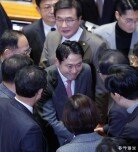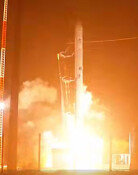Reform of KAIST
Even the combined number of research papers Korean research organizations published in the world-class scientific journal Nature does not match that of the University of Tokyo. In Asia, the Japanese university ranked first, Seoul National University 10th, and the Korea Advanced Institute of Science and Technology, or KAIST, 11th. The overall scores, which reflect partial participation in studies by individual authors, were 34.33 points for the University of Tokyo, 4.87 for Seoul National, and 4.59 for KAIST. The combined scores of all research organizations in Korea including universities, public research organizations and corporate think tanks, stood at 24.57 points, far behind that of the University of Tokyo.
Japan`s top university ranked sixth in the world but its score is less than half that of Harvard University, which ranks first with 72.72 points. This enables an estimate of the level of Koreas science education. Massachusetts Institute of Technology, or MIT, which KAIST President Suh Nam-pyo picked as his schools envisaged rival, ranks fifth, a notch higher than the University of Tokyo. This suggests how difficult it is for KAIST to overtake MIT and why KAIST faculty and students must renew their commitment and work harder.
Korea has a small territory and has few natural resources. The only thing the country can depend on is human resources. Korea owes its rise from one of the poorest countries after World War II to the world`s 13th-largest economy to its education and science and technology. Education, science and technology are the only resources Korea can boost its competitiveness with to maintain its economic power over the next ten years. With per capita income barely reaching 20,000 U.S. dollars last year, Korea can attain the 30,000 dollar level only when it becomes a science and technology powerhouse.
Since his inauguration in 2006, Suh has been pushing a reform campaign that includes toughened review standards for tenured professors, 100-percent English lectures in all undergraduate courses, and a cut in scholarships to underperforming students. Four KAIST students committed suicide recently, but a closer analysis shows that only one of them killed himself due to poor academic performance. If the KAIST suicide crisis delays the reform drive, it will mean that the school, which is supposed to be a scientific institution, is tackling the problem in the most unscientific way. A move to pressure KAIST to ease its reform drive by political and social circles is a populist measure that is irresponsible at best for the future of this nation, and represents to a certain extent political attacks on education policy.
At a recent general gathering, KAIST students voted down an agenda calling Suh Nam-pyos reform as a failure. They thus responded to the crisis in a mature fashion that lives up to their reputations as Koreas most talented science students. The schools board of trustees also decided to shelve deciding whether Suh will have to resign and ditch his reform drive. Wisdom is required to minimize side effects of reform, but if the school gives up reforming itself now, it will only distance itself from its goal of becoming a world-class university.
KAIST is one of a few universities in the world whose management is maintained wholly through tax money and donations. If a school that enjoys such great privileges cannot compete with world-class universities abroad, Korea is hardly assured of a bright future. Other Korean universities including Seoul National are hoped to renew their commitment and redouble efforts in light of Koreas standing in the journal Nature.




![[이진영 칼럼]“생리대가 아닌 집값·환율 잡아야”](https://dimg.donga.com/c/138/175/90/1/wps/NEWS/IMAGE/2025/12/23/133027424.1.jpg)


